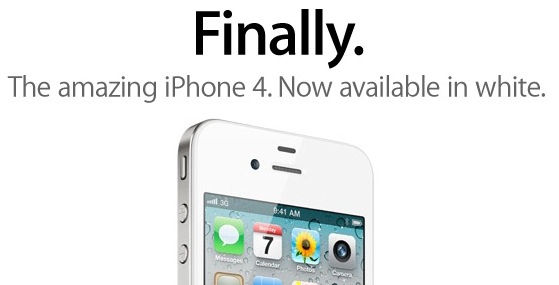"Finally" is the headline on Apple's homepage announcing the arrival of the white iPhone. It's Apple poking fun at itself for a long drawn-out techno failure, and shows exactly how Apple's again sprinkled a potentially bad affair with unicorn dust, and spun it into incredibly positive PR.
"By poking fun at itself with the 'Finally' remark, Apple looks a world away from the defensive company it appeared to be in 2007, when a few rogue questions caused an Apple PR to step in and halt an interview with British TV’s Channel 4 News," Rich Leigh, a PR rep with 10 Yetis and a columnist for a top U.K. PR magazine, tells us.
Just as the rumors had suggested, the Apple store went down for maintenance early this morning, and when it popped back up the white iPhone 4 was available to Apple buyers around the world. It's been a long wait, and the matter has been on many a mind for pretty much an entire year...because it's been almost that long since we were promised a white iPhone 4 by Steve Jobs himself.
It didn't arrive when the iPhone 4 went on sale in mid-2010 because Apple couldn't get its hardware working properly--the white coloring, combined with the iPhone 4's unusual glass frame meant the phone's proximity sensor and camera unit didn't function as they needed to. In other words, it was a big technological failure, from one of the world's biggest companies on one of its market-defining products.

Somehow, that's not the broader public perception, however. It's even thought that the much-delayed device, which mysteriously disappeared from Apple's website soon after it emerged it was failing in manufacture, could help boost iPhone sales through the summer and satisfy the consumer urge for Apple gadgets until a much later-than-expected launch of the next iPhone. The boost could be as much as 1.5 million extra sales per quarter.
Steve Jobs and Phil Schiller gave a rare interview yesterday to deflate the location tracking furor that's erupted recently, but they also were prepared to discuss the white iPhone. Schiller confirmed "it was challenging" to finally produce the device to satisfactory quality standards because "it's not as simple as making something white." Indeed, there's actually "a lot more that goes into both the material science of it--how it holds up over time...but also in how it all works with the sensors." This is a tacit confirmation that everything we'd heard about the technological difficulties was true, and that Apple and its manufacturing partners did make a big mistake--announcing a product that couldn't actually be produced in volume and go on sale.
Jobs, for his part, noted that Apple chose to pursue the white iPhone instead of simply dropping it from its plans (as perhaps other firms would've done, minimizing their loss) as part of an internal learning curve. Talking about the technological challenge of perfecting the white paint for the device and optimizing how the sensors work, Jobs said: "We obviously think about this in a generic way because you have a white iPad." Apple learned its lessons from making the white iPhone work and applied them to the newly refreshed iPad 2's front glass.
This kind of admission of failure from Schiller is almost chummy--it puts you, us, anyone who has tried and failed squarely on Apple's side. Jobs's assertion the company wanted to learn from its error is even more interesting--and could even be called admirable. Then there's that Apple.com homepage--"Finally." That's a trick to make the white iPhone affair funny, personal, with a self-deprecating "sorry, guys!" sense of humor you may use with friends.
It's Apple's sleek PR at work again--pulling off the same sort of maneuvers that ended the "antennagate" affair (do you even remember the details of that now? Bet you don't. And neither do millions of consumers who've bought the "flawed" iPhone 4 since).
Leigh reminds us that the trick isn't exactly new, "especially in the world of tech and video game PR." In fact, another recent example is that of the long-anticipated video game Duke Nukem Forever, which had been repeatedly delayed. Leigh reminds us "to appease fans, Gearbox Software's President Randy Pitchford put out a video entitled "A very special message from Gearbox Software," in which the company poked fun at yet another release date setback"--the video's been viewed half a million times, and rarely "disliked."
But in Apple's case, Leigh says, where "the white iPhone initially failed on the face of things, all it did is serve to whet the appetites of potential customers." Apple is "simply put, a PR monster," Leigh says, and its might and the "level of fanboyism surrounding the brand" definitely helps because "this sort of about-turn isn't easy to do."
Leigh also hints that Apple may be using the device to deflect attention away from the location fiasco, beating the "spying accusations in a straight reach-for-reach race" and this may be a deliberate ploy--although we're dubious on this suggestion, since Apple had to have the white iPhone engine engaged long before the location kerfuffle blew up.
In any case, the timing certainly didn't hurt Apple in its moment of good PR need--but the real power of its positive press comes from the company's willingness to look human in the face of failure.
No comments:
Post a Comment